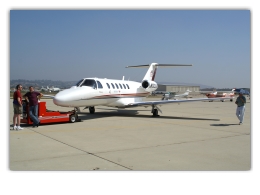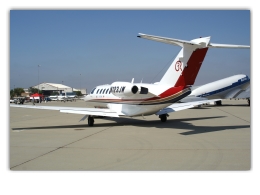

























Cessna 525A CitationJet CJ2
Twin-engine light corporate jet, U.S.A.
Archive Photos 1
Cessna 525A "CitationJet CJ2" (N123JW, s/n A0152) at the 2007 Camarillo Air Show, Camarillo, CA (Photos by John Shupek)


Cessna CitationJet/M2 Series Overview 2
- Cessna 525A CitationJet CJ2
- Role: Business jet
- National origin: United States
- Manufacturer: Cessna
- First flight: 29 April 1991
- Status: Active, In production
- Produced: 1991-present
- Number built: 2000 as of June 8, 2017
- Unit cost: M2: US$4.7M (2018); CJ2+: US$7.044M (2012); CJ3+: US$8.295M (2018); CJ4: US$9.195M (2018)
- Developed from: Cessna Citation II
- Developed into: Cessna 526 CitationJet
The Cessna CitationJet/M2/CJ series (Model 525) are light business jets built by Cessna and part of the Citation family. Launched in October 1989, its first flight was on April 29, 1991, FAA certification was awarded on October 16, 1992, first delivery happened on March 30, 1993, and by June 2017, 2,000 of all variants have been delivered. Powered by two 1,900 lbf (8.5 kN) Williams FJ44s, it uses the Citation II’s forward fuselage with a new carry-through section, straight wing, and T-tail. The basic model was updated with the CJ1/CJ1/M2 names, it was stretched in the CJ2/CJ2+ delivered since 2000, then further in the CJ3/CJ3+ delivered from December 2004 and finally in the CJ4 delivered since 2010.
Development 2
Cessna launched the $2.4 million model 525 CitationJet at the October 1989 NBAA convention in Atlanta, estimating a demand for 1,000 aircraft over ten years. Succeeding the 700 original Citation Is produced since 1972, first flight was scheduled for spring 1991, FAA certification in October 1992 and deliveries by the end of the year.
Its first flight was on April 29, 1991, FAA certification was awarded on October 16, 1992, and first delivery happened on March 30, 1993. Twenty years after its first flight, 1,450 CJs have been produced. As of June 2017, 2,000 of all variants have been delivered with five million hours flown.
Design 2
The six-seat jet uses the Citation II’s forward fuselage, a new carry-through section, a new laminar flow, supercritical wing developed with NASA and Boeing, and a T-tail. Powered by two 1,900 lbf (8.5 kN) Williams FJ44s, the 10,000 lb (4,500 kg) aircraft has a trailing link undercarriage for smooth landings and can be flown by a single pilot. Cabin length is reduced by 1 ft 6 in (46 cm), range is 1,500 nmi (2,800 km) with four passengers and it can cruise at 437 mph (380 kn).
Its FJ44 bypass ratio is 3.3:1 with a 16:1 overall pressure ratio, its wing area is 240 ft² (22 m²) and it can cruise at Mach 0.7 (413 kn; 764 km/h). It features EFIS avionics, its fuselage is 11 inches (27 cm) shorter than the Citation I’s, but has a lowered center aisle for increased cabin height. The CitationJet is a low-wing cantilever monoplane with retractable tricycle landing gear and a pressurized cabin, engines are pylon mounted on the rear fuselage.
Variants 2
Model 525
- CitationJet: Model 525 serial numbers 0001 to 0359, powered by Williams FJ-44-1A turbofans, are marketed as the CitationJet.
- CitationJet CJ1: Model 525 serial numbers 0360 to 0599 are marketed as the CitationJet CJ1 and are powered by the same Williams FJ-44-1A. It was improved with a more-modern EFIS avionics suite and a moderate increase in maximum takeoff weight.
- CitationJet CJ1+: Model 525 serial number 0600 and higher are marketed as CitationJet CJ1+ and are powered by Williams FJ-44-1AP turbofans. With the same airframe, it has an updated avionics package and FADEC engine control. The GE Honda HF120 engine was announced as a retrofit option for the CJ/CJ1/CJ1+ in 2014.
- Citation M2: Model 525 marketed as Cessna Citation M2 are powered by improved FJ44-1AP-21 turbofans offering 10 to 15% more cruise thrust and up to 5% more hot-and-high thrust, and are equipped with modern Garmin G3000 avionics replacing Rockwell Collins Pro Line 21. Launched in September 2011, it is based on the then out-of-production CJ1 variant and features a new cabin layout and a more efficient FJ44 version. The initial M2 prototype first flew on 9 March 2012, it was not a conforming airframe but was testing the Garmin G3000 avionics and Williams FJ44-1AP-21 turbofans while one another aircraft was expected to join the certification program in May 2012 to be used for aerodynamics testing. With 150 produced since introduction in 2013, it became Cessna’s entry-level jet after the Citation Mustang stopped production in May 2017.
Model 525A
- CitationJet CJ2: Model 525A serial numbers 0001 to 0299, marketed as the CitationJet CJ2 is a 5-foot stretch of the CJ1 (Model 525) powered by Williams FJ44-2C turbofans and first delivered in 2000.
- CitationJet CJ2+: Model 525A serial numbers 0300 and higher, marketed as the CitationJet CJ2+ and first delivered in April 2006, offer increased performance with updated avionics and Williams FJ44-3A-24 turbofans with FADEC control. In 2014, Cessna started offering an upgrade package for the CJ2+ called Alpine Edition. It incorporates Garmin G3000 avionics and new cabin stylings similar to those introduced by Cessna to the CJ1+ when it became the M2. The CJ2 went out of production due to low demand in January 2016.
Model 525B
- CitationJet CJ3: Model 525B are marketed as the CitationJet CJ3 are a further stretch of the CJ2 powered by Williams FJ-44-3A turbofans. Unveiled at the September 2002 National Business Aviation Association convention, it first flew on April 17, 2003, was FAA certified in October 2004 and deliveries began in December of that year. The cockpit with Rockwell Collins avionics is designed for single-pilot operation but can accommodate two crew members. Its customizable cabin typically has six club seats in a center-style configuration with an accessible in flight baggage compartment and external baggage access.
- CitationJet CJ3+: Garmin G3000 avionics. FAA certified in 2014.
Between its production debut in late 2004 till spring 2018, 500 have been delivered, 2004-2009 models are sold for $3.5 million and $5.0-5.5 million for 2009-2014 models. It can cruise at its Mach 0.737 (423 kn; 783 km/h) MMo at FL450 over 1,900 nmi (3,500 km) with four passengers, or more than 2,000 nmi (3,700 km) at a slower speed, exceeding Textron predictions.
Hourly, it burns 165 US gal (620 L) its engine maintenance cost $313.60, its parts $251.72 and labor cost is $298.
Model 525C
- Cessna Citation CJ4 (Model 525C): The stretched CJ4 was launched at the October 2006 NBAA conference. Its wing design comes from the moderately swept wing of the Citation Sovereign. Powered by Williams FJ44-4A turbofans, it has a maximum range of 2,165 nmi (4,010 km). Its cabin is 21 inches longer than the CJ3 and can seat up to nine persons plus one in the cockpit. It first lifted off on May 5, 2008, from McConnell AFB in Wichita, Kansas and first deliveries started in 2010.
- In 2011, the Federal Aviation Administration temporarily grounded the CJ4 and issued an airworthiness directive because of fires in the original Lithium-ion battery equipment: (Cessna) We are adopting a new airworthiness directive (AD) for certain Cessna Aircraft Company (Cessna) Model 525C airplanes. This emergency AD was sent previously to all known U.S. owners and operators of these airplanes. This AD requires replacing certain lithium-ion batteries installed as the main aircraft battery with either a Ni-Cad or a lead acid battery. This AD was prompted by a report of a battery fire that resulted after an energized ground power unit was connected to one of the affected airplanes equipped with a lithium-ion battery as the main aircraft battery. We are issuing this AD to correct the unsafe condition on these products.
Series Specifications 2
| Model | Cessna 525 Citation M2 (CJ1) | Cessna 525A CitationJet CJ2+ | Cessna 525B CitationJet CJ3+ | Cessna 525C Citation CJ4 |
|---|
| Crew | 1 or 2 |
|---|
| Max. Passengers | 7 | 9 | 9 | 10 |
|---|
| Length | 42 ft 7 in (12.98 m) | 47 ft 8 in (14.53 m) | 51 ft 2 in (15.59 m) | 53 ft 4 in (16.26 m) |
|---|
| Height | 13 ft 11 in (4.24 m) | 14 ft (4.27 m) | 15 ft 2 in (4.62 m) | 15 ft 5 in (4.69 m) |
|---|
| Wingspan | 47 ft 3 in (14.40 m) | 49 ft 10 in (15.19 m) | 53 ft 4 in (16.26 m) | 50 ft 10 in (15.49 m) |
|---|
| Wing Area | 240 ft² (22.3 m²) | 264 ft² (25 m²) | 294 ft² (27.32 m²) | 330 ft² (30.66 m²) |
|---|
| Wing Sweep | 0 degrees | 12.5 degrees |
|---|
| Cabin Section | 57 in (1.45 m) height, 58 in (1.47 m) width |
|---|
| Cabin length | 11 ft (3.35 m) | 13 ft 7 in (4.14 m) | 15 ft 8 in (4.78 m) | 17 ft 4 in (5.28 m) |
|---|
| MTOW | 10,700 lb (4,853 kg) | 12,500 lb (5,670 kg) | 13,870 lb (6,291 kg) | 17,110 lb (7,761 kg) |
|---|
| Fuel capacity | 3,296 lb (1,495 kg) | 3,930 lb (1,783 kg) | 4,710 lb (2,136 kg) | 5,828 lb (2,644 kg) |
|---|
| Fuel volume | 492 gal (1,862 L) | 587 gal (2,221 L) | 703 gal (2,661 L) | 870 gal (3,293 L) |
|---|
| Basic OEW | 6,990 lb (3,171 kg) | 8,030 lb (3,642 kg) | 8,540 lb (3,874 kg) | 10,280 lb (4,663 kg) |
|---|
| Max. payload | 1,410 lb (640 kg) | 1,670 lb (757 kg) | 1,970 lb (894 kg) | 2,220 lb (1,007 kg) |
|---|
| Turbofan × 2 | FJ44-1AP-21 | FJ44-3A-24 | FJ44-3A | FJ44-4A |
|---|
| Thrust (each) | 1,965 lb (8.74 kN) | 2,490 lb (11.08 kN) | 2,820 lb (12.54 kN) | 3,621 lb (16.11 kN) |
|---|
| Max. Cruise | 404 ktas (748 km/h) | 418 ktas (774 km/h) | 416 ktas (770 km/h) | 451 ktas (835 km/h) |
|---|
| Max. Range | 1,550 nmi (2,871 km) | 1,781 nmi (3,298 km) | 2,040 nmi (3,778 km) | 2,165 nmi (4,010 km) |
|---|
| Takeoff | 3,210 ft (978 m) | 3,360 ft (1,024 m) | 3,180 ft (969 m) | 3,410 ft (1,039 m) |
|---|
| Landing | 2,590 ft (789 m) | 2,980 ft (908 m) | 2,770 ft (844 m) | 2,940 ft (896 m) |
|---|
| Ceiling | 41,000 ft (12,497 m) | 45,000 ft (13,716 m) |
|---|
| Max. Climb Rate | 3,698 fpm (18.8 m/s) | 4,120 fpm (20.9 m/s) | 4,478 fpm (22.75 m/s) | 3,854 fpm (19.6 m/s) |
|---|
References
- Shupek, John. Photos, copyright © 2007 Skytamer Images (Skytamer.com). All Rights Reserved
- Wikipedia, the free encyclopedia. Cessna CitationJet/M2































































